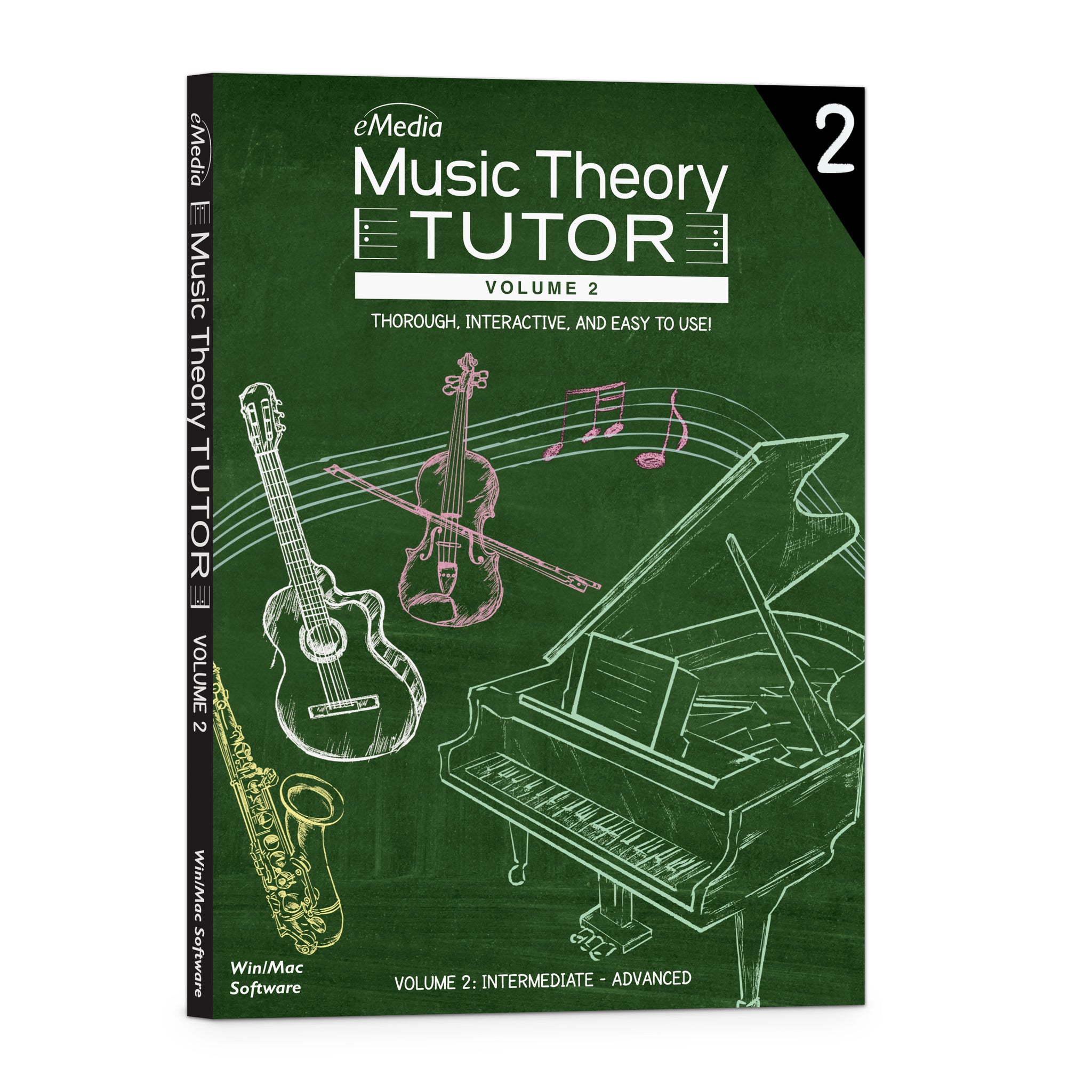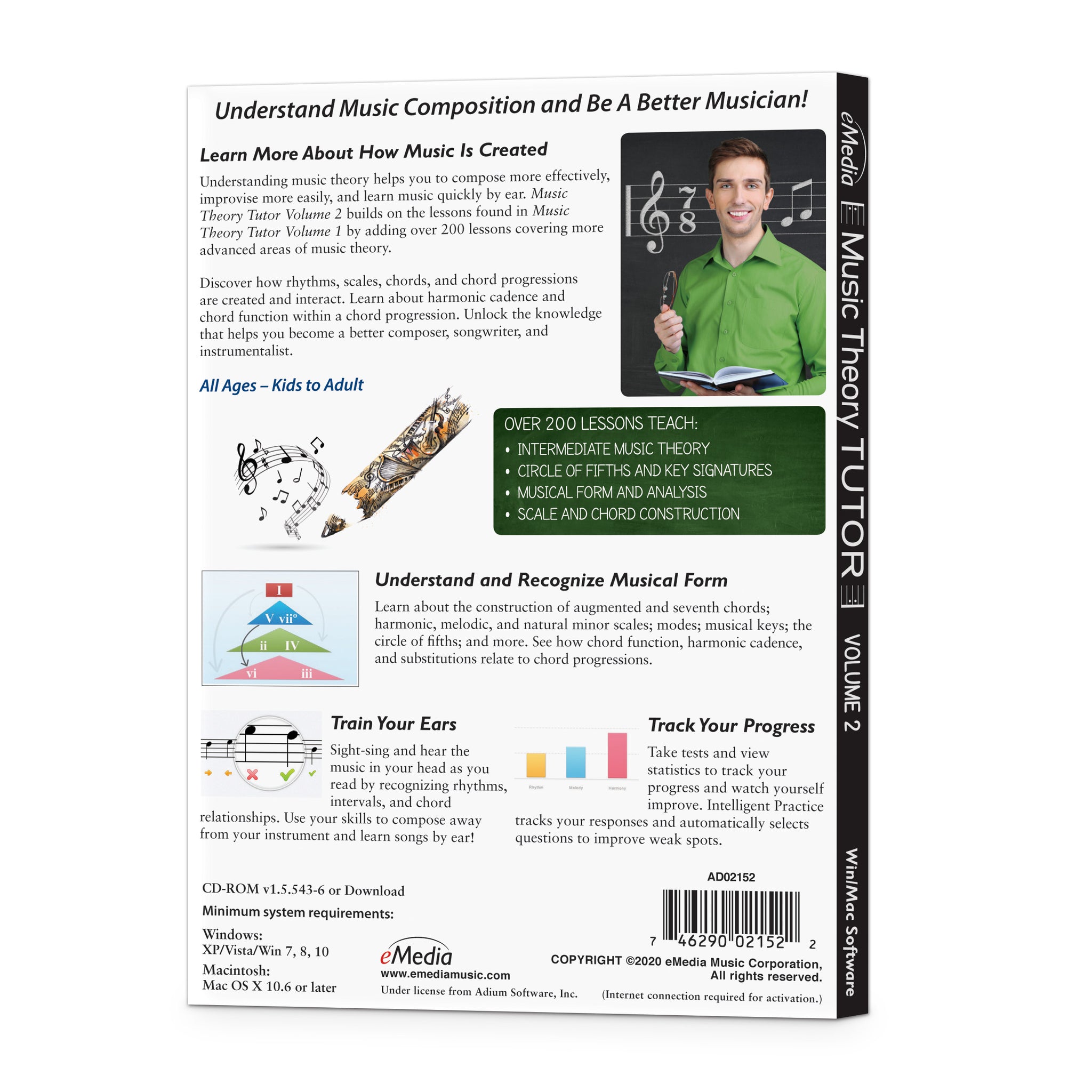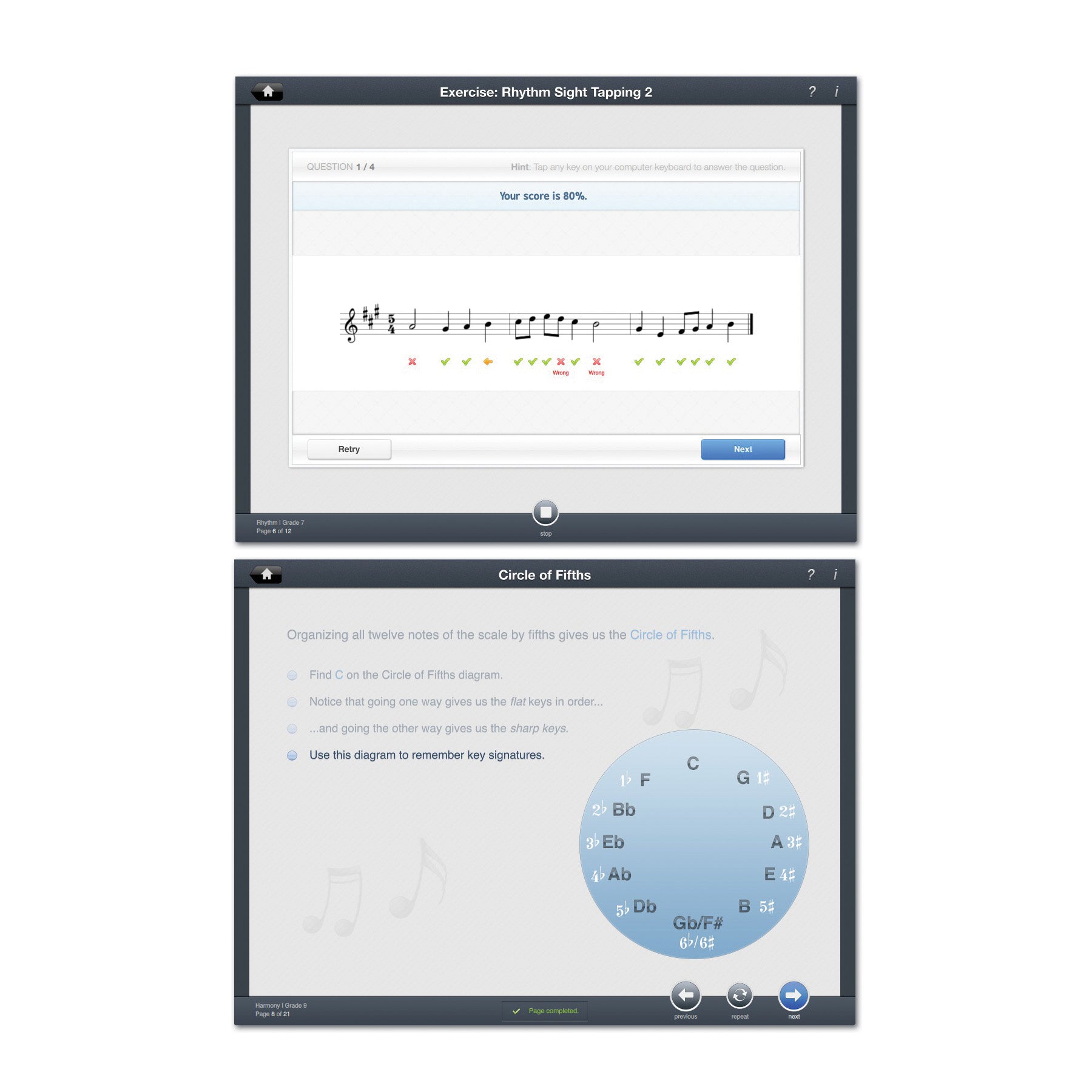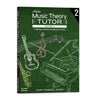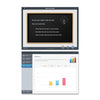eMedia Music Theory Tutor, Volume 2
“Offers a thoughtful, step-by-step introduction to ear training.”
– Dr. Erik Steighner, saxophonist and music teacher
- SKU: AD02152DLW
Discount Code Found:
However, this item is currently on sale, and discount codes may not be combined with other offers.
Click ‘Add to Cart.’ Then ‘Go to Cart’ and click ‘Proceed to Checkout’ to see it applied on the next page (if applicable to your order). Discount codes may not be combined with other offers.
Click ‘Add to Cart.’ Then ‘Go to Cart’ and click ‘Proceed to Checkout’ to see it applied on the next page (if applicable to your order).
Learn the Circle of Fifths, Chord Theory, and More with Intermediate to Advanced Music Theory Lessons!
eMedia Music Theory Tutor Volume 2 features over 200 lessons covering intermediate to advanced music theory topics and builds on the lessons found in eMedia Music Theory Tutor Volume 1. Learn about the construction of augmented and seventh chords; harmonic, melodic, and natural minor scales; modes; musical keys; the circle of fifths; phrasing; and more about melodic/harmonic relationships and cadences. Learn to analyze chord function and understand chord progression theory, complex time signatures, and syncopation to help you write and perform music better.

Images, audio, interactivity, and examples make it easier than ever to learn music theory. An Intelligent Practice feature in the music theory software acts an instructor would by analyzing your responses and skill levels and providing an individualized practice program to help you improve weak areas. Many lessons let you enter pitches simply by humming, singing, or playing your instrument into the computer's microphone. Tap rhythms, sing back melodies, guess intervals, and much more. eMedia Music Theory Tutor shows you when you are playing or singing the correct pitches in a lesson and lets you see your progress. Gain confidence as you pass music theory quiz at the end of each subject and at the end of every grade level completion.
Take your musical brain to the next level with eMedia Music Theory Tutor Volume 2!
Features include:
- Learn music theory with a step-by-step curriculum designed by Dr. Gregory Simon, who has a Ph.D. in music composition from University of Michigan and has taught at the University of Colorado.
- Both music theory lessons and ear training in one great course.
- Exercises feature graphics, interactivity, and sound to make learning easier.
- Intelligent Practice that tracks your progress and selects questions to improve weak spots.
- The ability to view scores for each music theory quiz and other statistics to measure your progress.
- Rhythm lessons in counting and recognition of triplets, complex time signatures (3/8, 6/4, 5/4, 7/4, 5/8, and 7/8), and syncopation.
- Interactive music theory lessons for learning major and minor key signatures and the circle of fifths.
- Training exercises so your ear can recognize harmonic intervals, minor scale types, modes, plus augmented and 7th chords.
- Lessons on harmonic, melodic, and natural minor scale construction and modes.
- Chord theory lessons cover construction and recognition of chords including inversions.
- Lessons on chord progression theory covering chord function and cadence within progressions (tonic, dominant, subdominant, etc.), Roman numeral (I, IV, V, etc.) and figured bass notation, plus chord substitutions, phrasing, passing and pedal tones.
- Harmonic flowchart, major, minor, and two-voice harmony studies.
- Lessons and exercises in musical form and analysis (binary, ternary, rondo, phrasing, etc.) help you better understand composition.
- A harmonic flowchart plus major and minor harmony studies.
- Solfege studies, with arpeggio and sight singing.
Over 200 Engaging Lessons. Understanding music theory helps you to compose better, improvise easier, and learn music by ear more effectively. eMedia Music Theory Tutor Volume 2 builds on the over 230 music theory lessons found in eMedia Music Theory Tutor Volume 1 by adding over 200 music lessons covering more advanced areas of music theory.
Understand and Recognize Musical Form. Learn about the construction of augmented and seventh chords; harmonic, melodic, and natural minor scales; modes; musical keys; the circle of fifths; and more. See how chord function, harmonic cadence, substitutions, and other factors relate to chord progressions.
Intelligent Practice. Answer questions the natural way. Tap out the answer to a rhythm question; hum two notes to identify an interval, sing the notes in a melody, or play them on your instrument. Learning music shouldn’t be about typing!
Learn More Complex Rhythms, Scales, Chords, and Concepts. Understand syncopation and counting in time signatures such as 7/4, 5/8, and 7/8. Find out how intervals define scales and chords and how chord cadence and inversions affect chord progressions.
Easily See Your Progress Through the Course. Built-in statistics and charts let you review your progress and test scores. See where your answers were correct were correct, lesson grades, and charts that show your overall progress.
eMedia Music Theory Tutor is developed by Adium Software.
Attention Educators, please visit our academic product page for information on using this product in schools or for private group instruction.
Also available: eMedia Music Theory Tutor Complete – a 2 Volume set featuring both Levels 1 and 2.
Learn the Circle of Fifths, Chord Theory, and More with Intermediate to Advanced Music Theory Lessons!
eMedia Music Theory Tutor Volume 2 features over 200 lessons covering intermediate to advanced music theory topics and builds on the lessons found in eMedia Music Theory Tutor Volume 1. Learn about the construction of augmented and seventh chords; harmonic, melodic, and natural minor scales; modes; musical keys; the circle of fifths; phrasing; and more about melodic/harmonic relationships and cadences. Learn to analyze chord function and understand chord progression theory, complex time signatures, and syncopation to help you write and perform music better.

Images, audio, interactivity, and examples make it easier than ever to learn music theory. An Intelligent Practice feature in the music theory software acts an instructor would by analyzing your responses and skill levels and providing an individualized practice program to help you improve weak areas. Many lessons let you enter pitches simply by humming, singing, or playing your instrument into the computer's microphone. Tap rhythms, sing back melodies, guess intervals, and much more. eMedia Music Theory Tutor shows you when you are playing or singing the correct pitches in a lesson and lets you see your progress. Gain confidence as you pass music theory quiz at the end of each subject and at the end of every grade level completion.
Take your musical brain to the next level with eMedia Music Theory Tutor Volume 2!
Features include:
- Learn music theory with a step-by-step curriculum designed by Dr. Gregory Simon, who has a Ph.D. in music composition from University of Michigan and has taught at the University of Colorado.
- Both music theory lessons and ear training in one great course.
- Exercises feature graphics, interactivity, and sound to make learning easier.
- Intelligent Practice that tracks your progress and selects questions to improve weak spots.
- The ability to view scores for each music theory quiz and other statistics to measure your progress.
- Rhythm lessons in counting and recognition of triplets, complex time signatures (3/8, 6/4, 5/4, 7/4, 5/8, and 7/8), and syncopation.
- Interactive music theory lessons for learning major and minor key signatures and the circle of fifths.
- Training exercises so your ear can recognize harmonic intervals, minor scale types, modes, plus augmented and 7th chords.
- Lessons on harmonic, melodic, and natural minor scale construction and modes.
- Chord theory lessons cover construction and recognition of chords including inversions.
- Lessons on chord progression theory covering chord function and cadence within progressions (tonic, dominant, subdominant, etc.), Roman numeral (I, IV, V, etc.) and figured bass notation, plus chord substitutions, phrasing, passing and pedal tones.
- Harmonic flowchart, major, minor, and two-voice harmony studies.
- Lessons and exercises in musical form and analysis (binary, ternary, rondo, phrasing, etc.) help you better understand composition.
- A harmonic flowchart plus major and minor harmony studies.
- Solfege studies, with arpeggio and sight singing.
Over 200 Engaging Lessons. Understanding music theory helps you to compose better, improvise easier, and learn music by ear more effectively. eMedia Music Theory Tutor Volume 2 builds on the over 230 music theory lessons found in eMedia Music Theory Tutor Volume 1 by adding over 200 music lessons covering more advanced areas of music theory.
Understand and Recognize Musical Form. Learn about the construction of augmented and seventh chords; harmonic, melodic, and natural minor scales; modes; musical keys; the circle of fifths; and more. See how chord function, harmonic cadence, substitutions, and other factors relate to chord progressions.
Intelligent Practice. Answer questions the natural way. Tap out the answer to a rhythm question; hum two notes to identify an interval, sing the notes in a melody, or play them on your instrument. Learning music shouldn’t be about typing!
Learn More Complex Rhythms, Scales, Chords, and Concepts. Understand syncopation and counting in time signatures such as 7/4, 5/8, and 7/8. Find out how intervals define scales and chords and how chord cadence and inversions affect chord progressions.
Easily See Your Progress Through the Course. Built-in statistics and charts let you review your progress and test scores. See where your answers were correct were correct, lesson grades, and charts that show your overall progress.
eMedia Music Theory Tutor is developed by Adium Software.
Attention Educators, please visit our academic product page for information on using this product in schools or for private group instruction.
Also available: eMedia Music Theory Tutor Complete – a 2 Volume set featuring both Levels 1 and 2.
Contents Summary
Grade 6
Rhythm
- Introduction
- Triplets in Simple Time
- Triplets in Simple Time (part 2)
- Triplets in Simple Time (part 3)
- Triplets in Simple Time (part 4)
- Exercise: Rhythm Sight Tapping
- Syncopation
- 3/8 Time Signature
- Exercise: Rhythm Sight Tapping 2
- 6/4 Time Signature
- Exercise: Rhythm Sight Tapping 3
- Rhythm Workshop
- Exercise: Rhythm Imitation
- Review: Time Signatures
- Before the Quiz
- Quiz
Melody
- Introduction
- Key Signatures
- Order of Flats and Sharps
- Order of Flats and Sharps (part 2)
- F Major Key Signature
- d minor Key Signature
- Exercise: Sight Singing
- G Major Key Signature
- e minor Key Signature
- Exercise: Sight Singing 2
- Melodic Intervals Review
- Exercise: Interval Singing
- Harmonic Intervals
- Harmonic Intervals (part 2)
- Exercise: Harmonic Interval Recognition
- Melody Workshop
- Exercise: Melody Imitation
- Review: Key Signatures
- Before the Quiz
- Quiz
Harmony
- Introduction
- Exercise: Chord Recognition
- Chord Function - Supertonic
- Chord Function - Supertonic (part 2)
- Chord Function - Submediant
- Chord Function - Submediant (part 2)
- Chord Function - Submediant (part 3)
- Exercise: Chord Progressions
- Perfect and Imperfect Authentic Cadences
- Half Cadence
- Deceptive Cadence
- Exercise: Cadence Recognition
- Inversions
- Inversions (part 2)
- Exercise: Inversion Recognition
- Figured Bass
- Figured Bass (part 2)
- Figured Bass (part 3)
- Before the Quiz
- Quiz
Grade 7
Rhythm
- Introduction
- Exercise: Rhythm Sight Tapping
- Odd Meters
- 5/4 Time Signature
- 7/4 Time Signature
- Exercise: Rhythm Sight Tapping 2
- Rhythm Workshop
- Rhythm Workshop (part 2)
- Exercise: Rhythm Imitation
- Review: Odd Meters
- Before the Quiz
- Quiz
Melody
- Introduction
- Review: Key Signatures
- Minor Scale Types
- Natural Minor
- Harmonic Minor
- Melodic Minor
- Exercise: Scale Singing
- Exercise: Scale Recognition
- Bb Major Key Signature
- g minor Scale
- Remembering Keys: Flats
- Exercise: Sight Singing
- Harmonic Intervals
- Harmonic Intervals (part 2)
- Exercise: Harmonic Interval Recognition
- Melody Workshop
- Exercise: Melody Imitation
- Review: Minor Scale Types
- Before the Quiz
- Quiz
Harmony
- Introduction
- First Inversion Chords
- Arpeggiation
- Substitution
- Exercise: Inversion Recognition
- Augmented Triads
- Triads Review
- Exercise: Chord Recognition
- Chord Function - Leading Tone
- Chord Function - Leading Tone (part 2)
- Chord Function - Leading Tone (part 3)
- Exercise: Chord Progressions
- Phrasing
- Phrasing (part 2)
- Phrasing (part 3)
- Phrasing (part 4)
- Binary Form
- Review: First Inversion Functions
- Before the Quiz
- Quiz
Grade 8
Rhythm
- Introduction
- Exercise: Rhythm Sight Tapping
- Quarter Note Triplets
- Quarter Note Triplets (part 2)
- Exercise: Rhythm Sight Tapping 2
- Rhythm Workshop
- Eighth-Based Odd Meters
- 5/8 Time Signature
- 7/8 Time Signature
- Exercise: Rhythm Sight Tapping 3
- Rhythm Workshop (part 2)
- Exercise: Rhythm Imitation
- Review: Odd Meters
- Before the Quiz
- Quiz
Melody
- Introduction
- Review: Key Signatures
- D Major Key Signature
- b minor Scale
- Remembering Keys: Sharps
- Review: Note Tendencies
- Harmonic Intervals
- Exercise: Harmonic Interval Recognition
- Exercise: Interval Singing
- Review: Minor Scales
- Exercise: Scale Recognition
- Exercise: Sight Singing
- Melody Workshop
- Exercise: Melody Imitation
- Before the Quiz
- Quiz
Harmony
- Introduction
- Exercise: Chord Recognition
- Ternary Form
- Ternary Form (part 2)
- Rondo Form
- Rondo Form (part 2)
- Seventh Chords
- Seventh Chord Qualities
- Major Seventh
- Minor Seventh
- Dominant Seventh
- Identifying Seventh Chords
- Exercise: Chord Recognition 2
- Second Inversion Functions
- Cadential 6/4
- Passing 6/4
- Pedal 6/4
- Exercise: Inversion Recognition
- Dominant Seventh Function (V7)
- Exercise: Chord Progressions
- Review: Second Inversions
- Before the Quiz
- Quiz
Grade 9
Rhythm
- Introduction
- Exercise: Rhythm Sight Tapping
- Advanced Triplets in Simple Time
- Advanced Triplets in Simple Time (part 2)
- Advanced Triplets in Simple Time (part 3)
- Exercise: Rhythm Sight Tapping 2
- Rhythm Workshop
- Exercise: Rhythm Sight Tapping 3
- Rhythm Workshop (part 2)
- Exercise: Rhythm Imitation
- Before the Quiz
- Quiz
Melody
- Introduction
- Eb Major Key Signature
- c minor Scale
- A Major Key Signature
- f# minor Scale
- Exercise: Scale Recognition
- Harmonic Intervals Review
- Exercise: Harmonic Interval Recognition
- Exercise: Interval Singing
- Modes
- Modes (part 2)
- Modes (part 3)
- Two Voice Melodies
- Two Voice Melodies (part 2)
- Exercise: Sight Singing
- Melody Workshop
- Melody Workshop (part 2)
- Exercise: Melody Imitation
- Before the Quiz
- Quiz
Harmony
- Introduction
- Exercise: Inversion Recognition
- Seventh Chord Review
- Diminished Seventh Chord
- Half-diminished Seventh Chord
- Exercise: Chord Recognition
- Inverted 7th (Harmony)
- Circle of Fifths
- Circle of Fifths (part 2)
- Chord Function - Mediant
- Chord Function - Mediant (part 2)
- Chord Function - Mediant (part 3)
- Harmonic Flowchart
- Chord Function - Supertonic Seventh
- Hearing Seventh Chords
- Exercise: Chord Recognition 2
- Harmonies in Minor
- Harmonies in Minor (part 2)
- Exercise: Chord Progressions
- Before the Quiz
- Quiz
What reviewers are saying...
“Well-thought-out music training application.”
– Softpedia
“Offers a thoughtful, step-by-step introduction to ear training.”
– Dr. Erik Steighner, saxophonist and music teacher
“This is a very, very cool tool for music teachers or any Mac user who wants to improve their singing or understanding of music.”
– Mac360
System requirements
Windows®:Windows 11 / 10 / 8 / 7 / Vista / XP
2.2GHz CPU, 2GB RAM
OpenGL-capable video card and driver
300 MB of hard drive space
Download or CD-ROM
macOS 10.6 or later
2.2GHz CPU, 2GB RAM
300 MB of hard drive space
Download or CD-ROM
Internet connection required for online activation. Requires a Windows desktop, laptop, or tablet device; or a Mac desktop or laptop computer. Not compatible with iPhones, iPads, Android, or Chromebook devices.
Questions about system requirements? Contact our technical support department.

